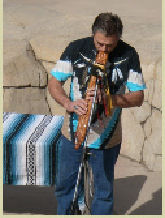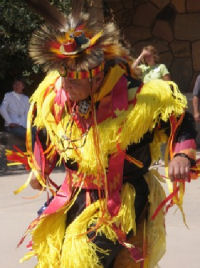 By Millicent Arko
By Millicent ArkoNovember 8, 2011 (San Diego) The San Diego Native American Flute Circle will perform a two-hour concert in the Mission Trails Amphitheater, Saturday, November 13, beginning at 1:00 p.m. In addition the Soaring Eagles Native American Dance Troop will exhibit its artistry at the event, which is free and open to the public.
The San Diego Native American Flute Circle currently has 51 members and they meet regularly at Mission Trails Regional Park on the second Sunday of each month.
The Native American flute is a spiritual instrument in Native American culture and is used as an instrument for
 meditation and healing among tribes. The flute is noted for its tranquil tone. The flute could be essentially considered a Native American instrument, since nearly every tribal nation has a flute of some sort.
meditation and healing among tribes. The flute is noted for its tranquil tone. The flute could be essentially considered a Native American instrument, since nearly every tribal nation has a flute of some sort.Native American flutes have a unique, mesmerizing sound -- the instrument can be played by itself or with accompanying percussion or other flutes.
 The "traditional" Native American flute was constructed using measurements based on the body — the length of the flute would be the distance from inside of the elbow to tip of the index finger. The length of the top air chamber, as well as the distance between the whistle and first hole, would be one fist-width. The distance between individual holes would be one thumb-width, and the distance from the last hole to the end would generally be one fist-width.
The "traditional" Native American flute was constructed using measurements based on the body — the length of the flute would be the distance from inside of the elbow to tip of the index finger. The length of the top air chamber, as well as the distance between the whistle and first hole, would be one fist-width. The distance between individual holes would be one thumb-width, and the distance from the last hole to the end would generally be one fist-width.
There are many stories about how different Native American people discovered the flute. A common character in these stories is the woodpecker, which put holes in hollow branches while searching for termites. The wind would blow around these branches, creating sounds that the people noticed and eventually sought to recreate.
Soaring Eagles Native American Dance Troop - Reasons to dance may be as numerous as dancers
 themselves, but for the Soaring Eagles, it is a way to connect with long-lost Native American ancestral roots.
themselves, but for the Soaring Eagles, it is a way to connect with long-lost Native American ancestral roots.Soaring Eagles were conceived in April 2008 and founded in June 2008 for students from grades K through 12, when local Native American parents felt there was a need to pass on to their children the Native American traditions of song and dance. Today, an average Soaring Eagles class contains 30 to 40 children, ranging from toddlers to teenagers, all from a variety of tribal backgrounds.
Every Wednesday the group meets for dance instruction accompanied by live drumming and singing, a potluck dinner, and Native American storytelling, history, and prayer. As of last spring, parents joined the classes as they too wanted to learn how to dance.
Powwow -The Powwow, an outdoor celebration of song and dance is of great importance to Native American culture. Powwows are the core of the American Indian community, facilitating communication through a ritual gathering of community members who help to preserve and pass on the Native American culture.The drum is instrumental to the culture of the Native American and a centerpiece of a powwow.
The drum helps everyone attending the powwow to achieve balance and feel the heartbeat of the Earth Mother. Powwows are held year-round, in Southern California providing many performance opportunities. Soaring Eagles dancers attend powwows about once a month in addition to other performances, mostly at elementary schools, parades, college campuses, and cultural events.
The dancers’ elaborate, colorful regalia, often embellished with intricate geometric designs are chosen by each dancer. In order to outfit the Soaring Eagles dancers, parents participate in sewing classes held concurrently with their children’s dance classes. Most of the material is donated, including custom-made moccasins.
Soaring Eagles offers far more than learning to dance: For many children, it’s the first opportunity they’ve had to learn Native American culture and to take pride in their heritage.
 Significance of Dance - Dances, songs and chants have played a major role in the culture of Native Americans. Stories and histories have been passed from generation to generation by voice as well as movement, rather than by written word. Dances are performed for a variety of reasons and usually most dances are performed either by only men or only women. Chants have special meanings and can last for hours or days.
Significance of Dance - Dances, songs and chants have played a major role in the culture of Native Americans. Stories and histories have been passed from generation to generation by voice as well as movement, rather than by written word. Dances are performed for a variety of reasons and usually most dances are performed either by only men or only women. Chants have special meanings and can last for hours or days.
Most dances are performed in a circle, as the circle symbolizes a long and continuous life without end.
Native Americans have kept their culture vibrant and meaningful through the power of dance. Different dances have different purposes, from telling a story to honoring an animal to performing a sacred ceremony.
Location and Contact Information:
Mission Trails Regional Park, One Father Junipero Serra Trail., San Diego, CA 92119,
(619) 668-3281or visit: mtrp@mtrp.org







Recent comments